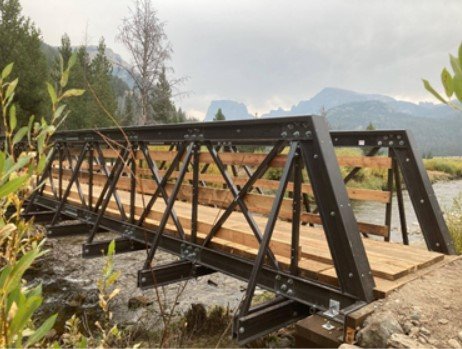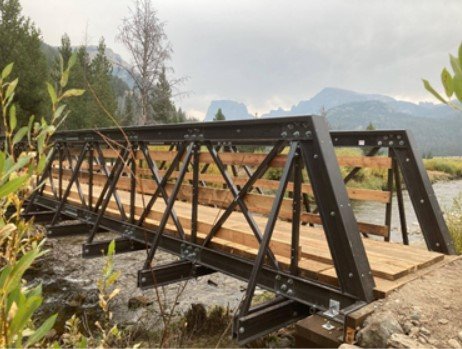Typically, we think of bridges as a means of crossing or accessing a previously inaccessible location. Bridges provide physical access and have the potential to enhance the community, bring others together, offer an attractive outdoor element, and encourage nature exploration.
The article below highlights the importance of a pedestrian bridge and how it can add value to your project.
Why a Pedestrian Bridge is Important
A bridge offers numerous benefits that help draw more people to a location, ultimately increasing the location value.
Accessibility
Bridges offer a great way to access a place that was not previously accessible. It provides ways to allow more people to access your location for an intended purpose.
A few examples include:
- Allowing people with disabilities to now have access to these locations.
- Increasing the network of trails for hiking, mountain biking, horseback riding, and snowmobiling.
- Convenient accessibility for golf courses and other outdoor attractions.
Connection to Nature
Pedestrian bridges can provide access to natural features. This includes a long range view, a waterfall, a swamp, or merely increasing the trail system’s mileage.
For example, did you know that swamps cover about 6% of the earth’s surface? Swamps have an abundance of wildlife. They are nesting and breeding grounds for birds and other animals but are generally inaccessible to humans. A walkway through a swamp can provide a great way to observe nature.
Connection to Community
Bridges create an opportunity to bring communities and people together; they can connect neighborhoods, shopping outlet centers, or community parks. Bridges provide opportunities for families and friends to gather and experience community together.
Aesthetics: Artwork and Iconic Images

In the right setting with the right materials, bridges can become the destination. Pedestrian bridges are a beautiful addition to a trail system. Bridges can be used to optimize and enhance the location’s beautiful view. For example, a bridge built in the right position enhances the view of an iconic mountain for trail users.
Nature can be incorporated as part of design by finishing a covered bridge with rhododendron branches to create a stunning stream crossing. Ultimately, bridges create opportunities for people to connect with one another and nature
Pedestrian Bridge Design Considerations
Understanding the type of bridge needed for space can help you determine if a pedestrian bridge is a right choice.
Here are a few bridge design considerations to keep in mind.
Environmental Considerations
Will the bridge cross over a body of water or through a swamp? Do you need to have a geotechnical analysis? Or a flood study? Will it be an overpass of a highway?
Knowing the environmental constraints will help you design the bridge.
Durability and Design Life
There is an inherent trade-off in cost versus the life-span of the bridge. A trail bridge constructed entirely of wood may be the least expensive option; however, it may only last a few years. A bridge built of steel can last longer. However, steel bridges are difficult to construct on an interior trail system and cost more.
A fiber-reinforced polymer (FRP) bridge may have a higher upfront cost but is light, durable, and requires minimal maintenance. Likewise, when selecting the bridge’s walking surface, or decking, choose the material based on durability, strength, and surface. The decking should not be slippery to walk on, hard on horse hooves, or make biking difficult for users.
Bridge Dimensions and Strength
What size does the bridge need to be? The length will depend on the environmental conditions (i.e., the width of a stream). Will it need to accommodate only foot traffic to support golf carts or maintenance vehicles? Will rail heights need to be adjusted to maintain views? Do you know the total weight the bridge needs to hold? Will it need to support bikes or small motorized vehicles?
Understanding vehicle and foot traffic will help determine how wide and how much support the bridge will need. Bridges are always designed using National AASHTO Standards and with ample safety factors in mind.
Contact Us for More Information on the Importance of a Pedestrian Bridge
The importance of pedestrian bridges far exceeds a crossing structure. They provide a decorative appearance that helps to connect people with nature, communities and create beautiful memories.
To determine if a pedestrian bridge is right for you, reach out to Areté Structures. The Areté Structures team will work with you during the planning and design process.

